Chaharshanbe Suri is a lively, joyful, and delightful celebration held on the last Wednesday night of the year, marking the prelude to the Persian New Year.
Chaharshanbe Suri is a traditional Iranian festival held at dusk on the last Tuesday of the solar year, just before Nowruz (Persian New Year). It involves various customs like fire-jumping, fireworks, and eating special mixed nuts. Family gatherings, spoon-banging, and other rituals are also part of the celebration, though some customs have been forgotten over time.
Chaharshanbe Suri is one of the most vibrant pre-Nowruz rituals in Iran, where fire, its main element, symbolizes the festival’s name, derived from fire flames. However, the modern use of explosive materials has made this festival risky, leading to physical injuries and even fatalities. This celebration is not tied to any specific religion or ethnicity; everyone from Muslims to Zoroastrians, Christians, etc., participate and pass it down through generations. It is also celebrated in other countries like the Republic of Azerbaijan, Afghanistan, Turkey, and by Iranians living abroad. For more on Chaharshanbe Suri, its history, and customs, follow this article.
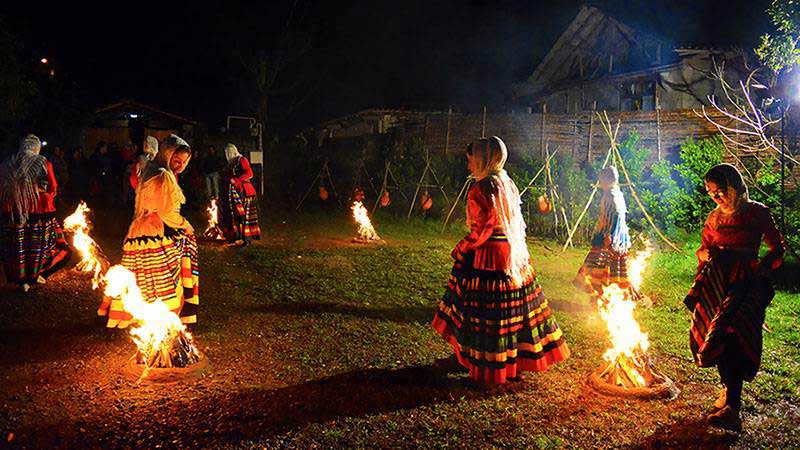
Chaharshanbe Suri’s Etymology
Chaharshanbe Suri is one of the Iranian festivals celebrated on the evening of the last Tuesday of the year, with unique customs. Some researchers interpret the word “Sur” as “celebration,” while others link it to the Pahlavi word “Surik,” meaning “red,” symbolizing fire’s redness or individual health and vitality. This interpretation is supported by the term “Chārshambe-Surkhi” in Isfahan.
Chaharshanbe Suri is known by various names in different regions of Iran, like Gool Goleh Chaharshanbe in Gilan, Choarshemeh Koleh in Kurdistan, Chārshambe-Surkhi in Isfahan, and Koleh Chaharshanbe in Qazvin. Despite common elements, each region celebrates Chaharshanbe Suri with its own customs.
When is Chaharshanbe Suri?
Contrary to its name, Chaharshanbe (Wednesday) Suri starts from the evening of the last Tuesday of Esfand (Persian month) and continues into the night.
History of Chaharshanbe Suri
Since Iranians before Islam named the days of the month and didn’t have weeks or specifically Wednesdays, and since jumping over fire and disrespecting it contradicts Zoroastrianism, some believe Chaharshanbe Suri is not a pre-Islamic celebration.
Discussing its connection to Zoroastrianism, Zoroastrian researcher and author Katayoun Mazdapour says:
“Iranian festivals and rituals belong to all Iranians. Many date back to before the Aryan migration to this land, and many were never Zoroastrian, like Chaharshanbe Suri.”
The earliest reference to Chaharshanbe Suri is in “Tarikh-e Bukhara” by Abu Bakr Muhammad ibn Jafar Narshakhi, indicating that it wasn’t mentioned in pre-Islamic texts and became popular in Iran after Islam. One reason is its timing on the last Wednesday night of the year, which aligns with the lunar calendar where Wednesday starts from Tuesday evening.
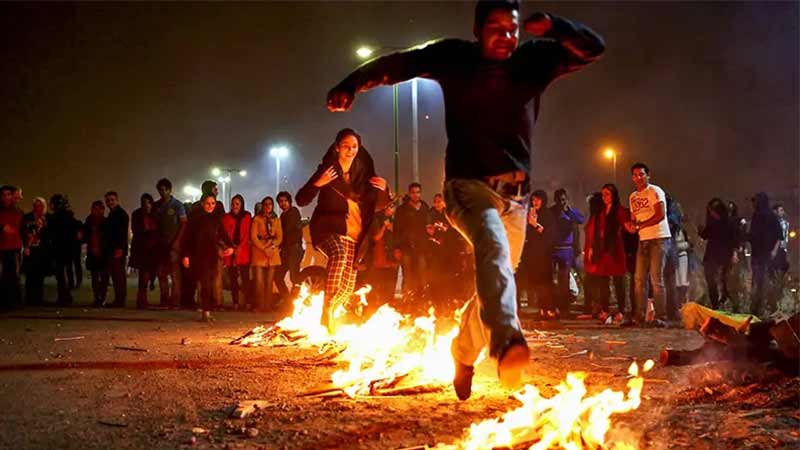
Additionally, Arabs considered Wednesday unlucky and avoided it for weddings, travels, etc. This is mentioned in a verse by Manuchehri Damghani:
“Wednesday, the day of misfortune, drink wine in Sātakīn for safety.”
Iranians might have started celebrating on the last Wednesday to ward off this unluckiness. So, it seems Chaharshanbe Suri in its current form wasn’t celebrated before Islam. However, the initial form of lighting fires on rooftops in some Iranian regions like Southern Khorasan, still practiced today, shows its ancient roots in Iran.
Evidence suggests the festival’s ancient origins, even predating Zoroastrianism in Iran. Originally, there were no weeks in ancient Iran, and Chaharshanbe Suri was celebrated in the last 10 days of the year. It likely became fixed on the last Wednesday during the early Islamic era to remove misfortune.
Lighting fires on rooftops, the last ritual of the end-of-year days or Gahambar Panje, involved fire-lighters visiting towns and villages before Nowruz as messengers of this divine celebration. These skilled men and women entertained people with street performances, songs, etc. From seven days before Nowruz to its fourteenth day, fires were lit in various city and village spots at dusk, symbolizing light, friendship, and love. The aim was to return the power of goodness to people, helping them overcome grief and depression.
On Chaharshanbe Suri night, fires were lit on most rooftops, believed by our ancestors to guide the departed souls’ Fravashis towards their homes. Historical references to Chaharshanbe Suri can also be seen in Chehel Sotoun Palace. A painting in the palace’s southern section, created under Reza Abbasi’s supervision during the Safavid era, depicts a fire and a gathering similar to Chaharshanbe Suri.
Chaharshanbe Suri in Shahnameh
Traces of Chaharshanbe Suri can be found in Shahnameh; some researchers consider Siavash’s passage through fire to prove his innocence as the origin of Chaharshanbe Suri.
Siavash, trapped in the love and temptation of his stepmother Sudabeh, is asked by his father Kay Kavus to pass through seven tunnels to prove his innocence. Thus, Siavash emerges unharmed from the fire on the last Tuesday of the year, and Kay Kavus declares a national celebration from Wednesday to Friday, with people celebrating nationwide.
Since then, Iranians jump over fires on Tuesday nights each year in memory of Siavash’s purity, celebrating the day.
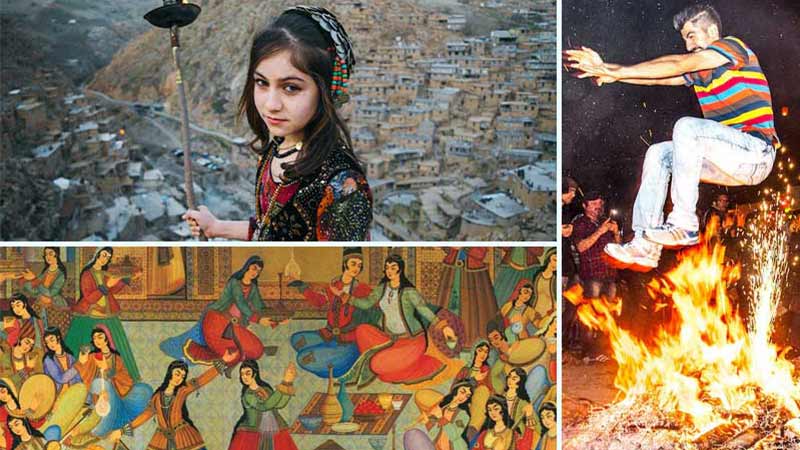
Philosophy of Chaharshanbe Suri
Chaharshanbe Suri is essentially a prelude to Nowruz celebrations, with people welcoming spring by organizing it. The main principle of this ancient ritual is lighting a large fire and jumping over it to discard sickness and problems into the fire, gaining health, energy, and warmth from it. Other practices like burning wild rue, broom burning, vitriol burning, disposing of old items, scattering fire ashes outside the house, and even breaking pots are all aimed at warding off evil and the evil eye.
One philosophy behind the celebration and fire-lighting is escaping the cold and seeking warmth. Aryans considered fire purifying and a means for self-cleansing. Iranians also believed that the spirits of the deceased visit Earth for ten days from the last five days of the year until five days after Nowruz. This belief likely gave rise to Chaharshanbe Suri. People lit fires on rooftops on the first night of these last five days, performing a sacred act and guiding the spirits home. The story didn’t end there; people prepared for the New Year by cleaning their homes and wearing new clothes, appeasing the spirits and dispelling enmities and grudges.
Customs of Chaharshanbe Suri
In the last days of the year, preparing for Nowruz and the New Year, Chaharshanbe Suri brings a unique excitement to different parts of the country.
As per tradition, on Chaharshanbe Suri night, younger people visit elders to spend the night joyfully together. A day or two before, people gather wood or bushes; in some cities like Gilan, rice stalks, and in Khor, palm leaves are used. On Tuesday afternoon, these woods are stacked in open areas like house courtyards, streets, or village squares, a few meters apart. At dusk, people light these woods, and everyone gathered around the fire, from women and men to the elderly and youth, jump over it chanting, “Your redness is mine, my paleness is yours,” to give away their paleness and weakness of sickness and sorrow to the fire and take away health and happiness. Other phrases like “Sorrow go away, happiness come, hardship go away, fortune come!”, “Oh Wednesday night, oh key to four locks, grant my wish!” are also chanted in Tehran while jumping over the fire.
Fireworks are just a part of this festival; family gatherings and being together conclude these ancient ceremonies.
In some parts of Iran, following an old tradition, fires are lit on rooftops, and after all household members jump over it, they let the fire extinguish itself or put it out with a water jug. Then, a family member collects the ashes with a dustpan and takes them outside the house. Interestingly, upon returning home, they knock on the door, and this interesting conversation occurs between them and the household members: “Who is it?” “It’s me,” “Where are you coming from?” “From a wedding,” “What have you brought?” “Health.”
A ceremony called “Dərəndəz” or “Diyarandârâj” on February 14 (25th of Bahman) is held by Iranian Armenians, similar to Chaharshanbe Suri, including jumping over fire.
Unfortunately, the traditional festival of Chaharshanbe Suri has undergone changes in recent years. Today, we see the use of explosives and hear terrifying explosion sounds throughout the city. Instead of burning bushes and wood, people now burn paper and plastic, creating extra work for the city cleaners and causing significant sound pollution and physical harm to the public. This ancient custom, once a reason for family and community gatherings, now instills fear and can lead to severe burns or even death.
Research shows that all Iranian customs, some of which are still prevalent, were deeply rooted in our ancestors’ wisdom. They were intertwined with beliefs in God, the fight against evil, and the hope for life. The current violent behavior during Chaharshanbe Suri was never a part of these traditions.
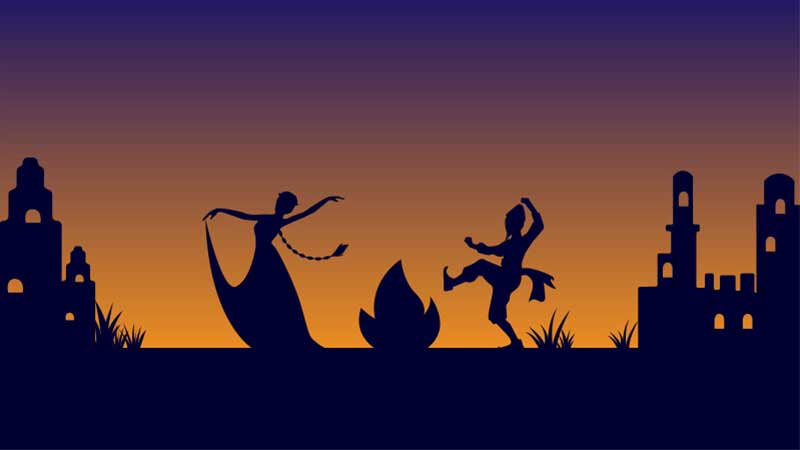
In addition to lighting fires and jumping over them, various regions in Iran have their own unique customs. For example, some families start spring cleaning the day after Chaharshanbe Suri, and in places like Shiraz, people cook Ash Reshteh (noodle soup) on this day. This article will explore some of the main customs of Chaharshanbe Suri.
Pot Breaking
Breaking pots is an interesting yet forgotten Chaharshanbe Suri tradition. People believed that breaking a pot would eliminate the household’s bad luck. However, there are variations; for instance, in Tehran, people throw pots filled with coins from rooftops. When Tehran had a drum house in its main square, people would drop new pots over their heads into the drum house to ward off misfortune.
In Khorasan, people fill a clay pot with a coin (symbolizing poverty), some salt (for envy), and charcoal (for bad luck). Each family member spins the pot around their head, transferring any misfortunes to the pot, which is then thrown from the roof while saying, “I throw the household’s pain and suffering into the street.”
In Arak and Ashtiyan, people fill the pots with barley grains. In southeast and eastern Iran, people often use unused pots, probably for hygienic reasons. In the past, Iranians believed that clay vessels should not be kept for more than a year. Breaking them before the new year was a way to dispose of them and also helped the pottery business.
In some areas, the pot-breaking ceremony is performed in the afternoon of Chaharshanbe Suri. As they break an old clay pot, families say, “Go away, unlucky Wednesday, never to return. Take all misfortune with you.”
Spoon Banging
In the Spoon Banging ceremony, young boys and girls cover their heads with scarves to remain unrecognized. They visit seven neighbors, banging spoons against bowls. The householders fill their bowls with treats like nuts, chocolates, sweets, sugar cubes, or money. According to tradition, those who receive gifts from the homeowners will have their wishes granted.
Eavesdropping
Another Chaharshanbe Suri tradition, especially among young girls, is to stand at a crossroads in the evening and eavesdrop on passersby. If they hear happy and positive conversations, they believe their wishes will come true. Hearing sad and bitter talks, however, indicates that their desires might not be fulfilled in the new year.
Throwing Shawls
The Shawl-Throwing ceremony is another forgotten custom, though it’s still practiced in some parts of Iran like Hamedan and Zanjan. Young people tie several silk and muslin handkerchiefs together to make a long, colorful rope. They drop one end of this cloth rope down a neighbor’s chimney and cough loudly to announce their presence. The neighbor, upon seeing the rope, fills the end of the shawl with gifts prepared for Chaharshanbe Suri and ties it up. When the shawl is tugged gently, the person pulling it knows to lift it back up.
The contents of the shawl also serve as a form of fortune-telling. Bread signifies sustenance, sweets for happiness, pomegranates for fertility and many children, while receiving nuts like hazelnuts and almonds symbolizes resilience, walnuts longevity, silver coins good fortune or marriage proposals, and raisins a fruitful new year.
Fireworks
Fireworks have become a prominent part of Chaharshanbe Suri celebrations, overshadowing other traditional activities. It’s unclear when fireworks (such as sparklers and firecrackers) became part of this festival, but traces can be found in the Qajar era. Back then, fireworks were used in festivities and were both a royal and public entertainment. European travelers who visited Tehran during the Qajar period also mentioned fireworks.
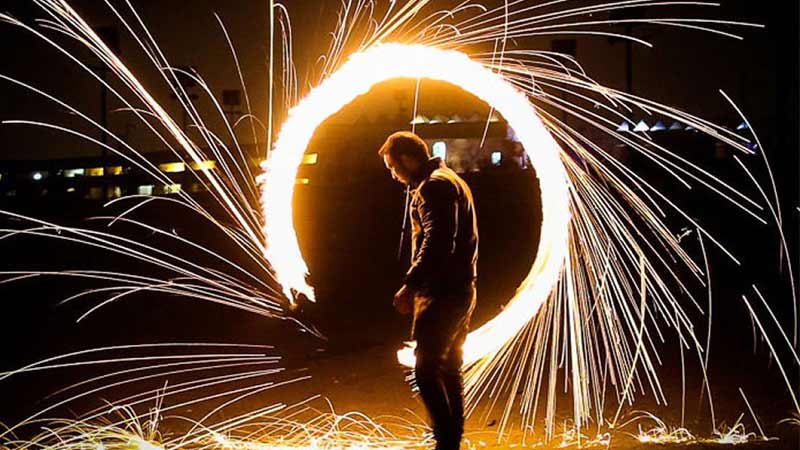
Eating Trail Mix
In the past, families and relatives would gather and roast the last remaining winter store of seeds and nuts like pumpkin seeds, watermelon seeds, pistachios, hazelnuts, wheat, and poppy seeds, almonds, and melon seeds. They would bless these nuts and seeds with salt before eating.
Our ancestors believed that eating this mixture would make people kinder and keep evil at bay. According to medical science, nuts, being rich in various vitamins and nutrients, help ward off depression and illness.
Water Splashing
In some rural areas of Iran, people would silently pick up a jar or pot on the last Tuesday evening of the year and head to a river, stream, or spring. After filling the pot with water, they would return home and sprinkle the water on the doors, walls, and household items.
Sometimes, they would splash water on anyone they encountered on the way, wishing them health and happiness in the new year. Some would also enter a spring or river and splash water on the onlookers for blessings.
Fortune Opening
In the past, unmarried girls had their own special Chaharshanbe Suri ceremonies. One such tradition involved buying some sugar and seven walnuts from a herb shop facing Mecca. They would then go to a pottery wheel, ride it seven times, breaking a walnut each time while reciting specific poems to open their fortunes. Finally, they would give the potter the sugar and money and return home.
Wish Balloons
A recent addition to Chaharshanbe Suri customs is releasing wish balloons into the sky, which is not originally part of our culture. People light these balloons and send them skyward, making wishes as they do.
Divination with a Small Wide-Mouthed Pot
Divination using a small wide-mouthed pot (Boluni) is one of the sweeter old customs of Chaharshanbe Suri, mostly for fun. Boluni, a small pot used to store pickles, jam, spices, etc., was used in this game. Women and young girls would gather, each throwing something into the pot. They would also write poems on pieces of paper and toss them into the pot. One person would then draw a paper from the pot, read the poem, and then pull out an item from the pot. The poem was believed to describe the fate and feelings of the item’s owner.
Conclusion
In conclusion, Chaharshanbe Suri is a lively and meaningful celebration in Iranian culture, marking the end of the year by jumping over fires. It’s a time for joy, getting rid of bad feelings, and looking forward to the future. If you enjoyed reading about Chaharshanbe Suri, please share your thoughts or ask questions in the comments. We’d love to hear from you!



